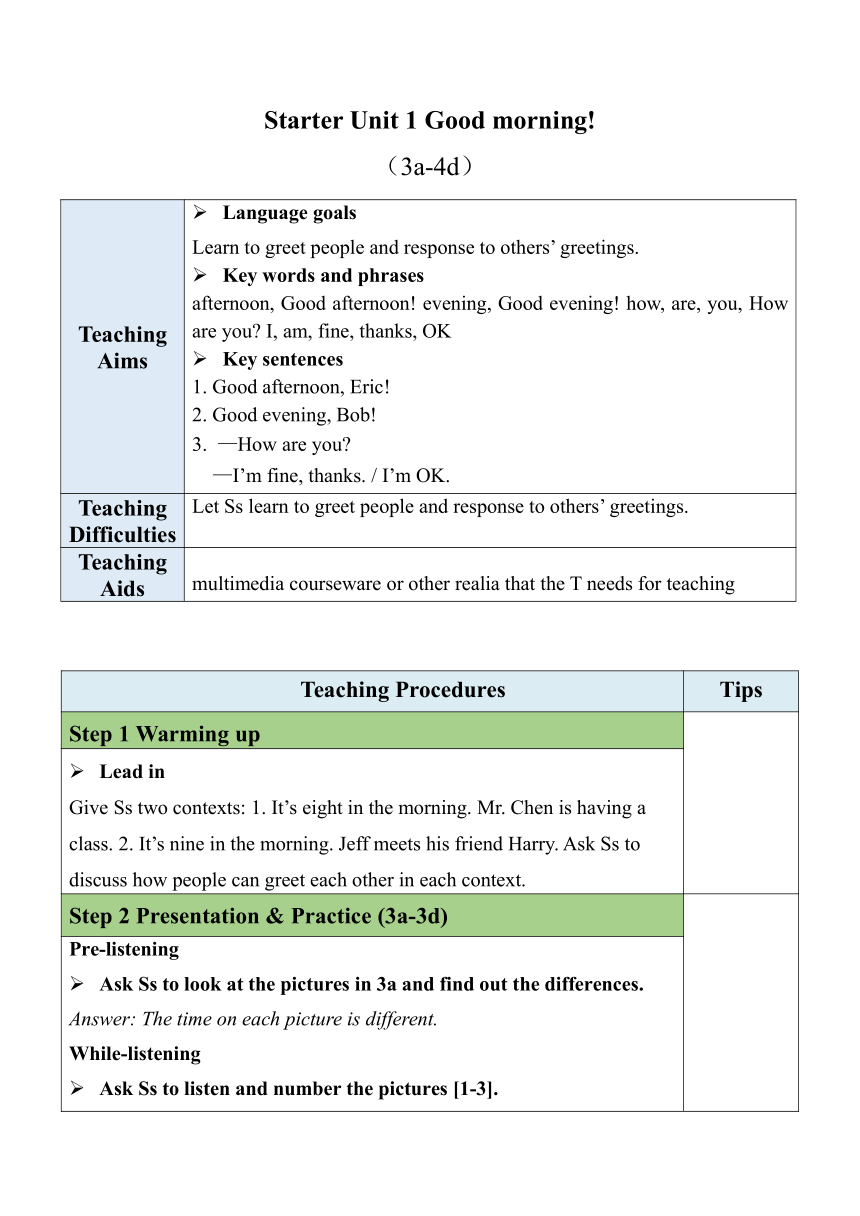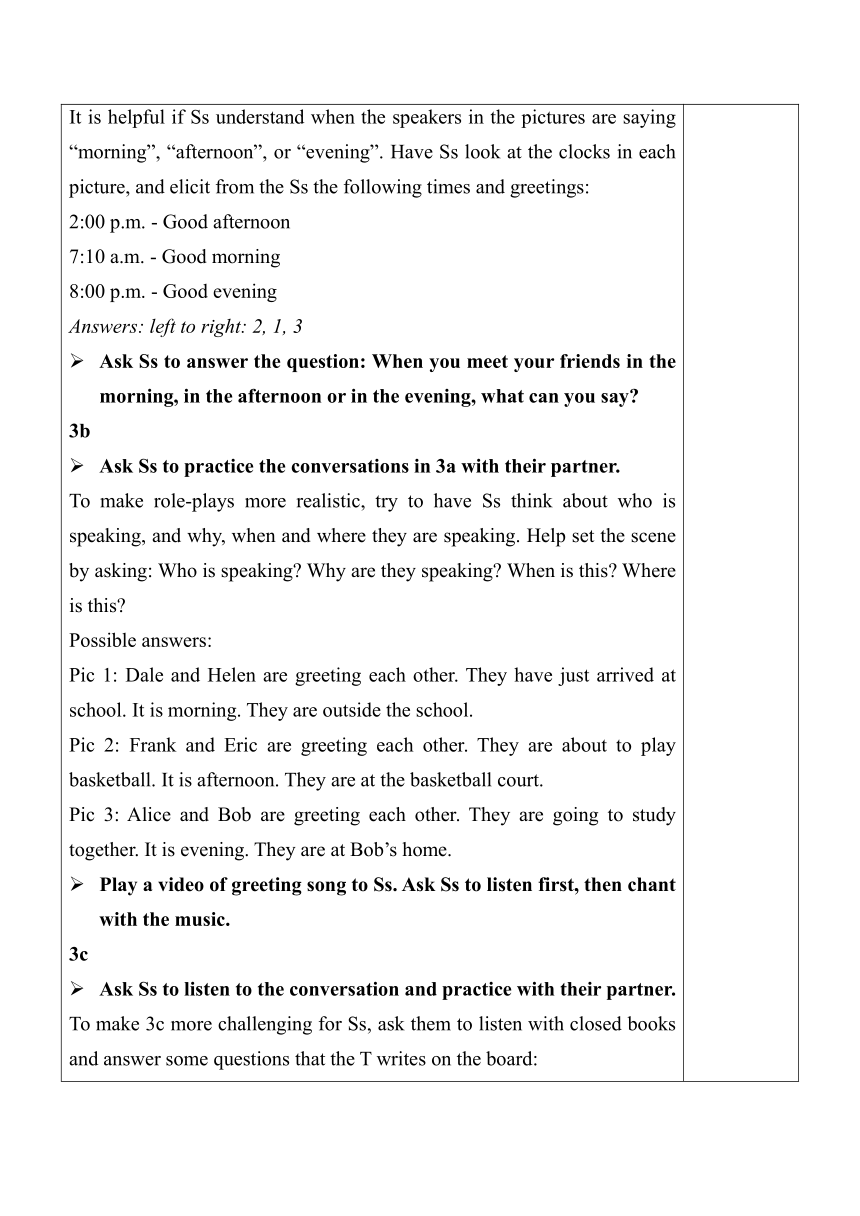人教版 Starter Unit 1 Good morning!(3a-4d)教案(表格式)
文档属性
| 名称 | 人教版 Starter Unit 1 Good morning!(3a-4d)教案(表格式) |  | |
| 格式 | docx | ||
| 文件大小 | 19.0KB | ||
| 资源类型 | 教案 | ||
| 版本资源 | 人教新目标(Go for it)版 | ||
| 科目 | 英语 | ||
| 更新时间 | 2023-10-13 23:24:47 | ||
图片预览


文档简介
Starter Unit 1 Good morning!
(3a-4d)
Teaching Aims Language goals Learn to greet people and response to others’ greetings. Key words and phrases afternoon, Good afternoon! evening, Good evening! how, are, you, How are you I, am, fine, thanks, OK Key sentences 1. Good afternoon, Eric! 2. Good evening, Bob! 3. —How are you —I’m fine, thanks. / I’m OK.
Teaching Difficulties Let Ss learn to greet people and response to others’ greetings.
Teaching Aids multimedia courseware or other realia that the T needs for teaching
Teaching Procedures Tips
Step 1 Warming up
Lead in Give Ss two contexts: 1. It’s eight in the morning. Mr. Chen is having a class. 2. It’s nine in the morning. Jeff meets his friend Harry. Ask Ss to discuss how people can greet each other in each context.
Step 2 Presentation & Practice (3a-3d)
Pre-listening Ask Ss to look at the pictures in 3a and find out the differences. Answer: The time on each picture is different. While-listening Ask Ss to listen and number the pictures [1-3]. It is helpful if Ss understand when the speakers in the pictures are saying “morning”, “afternoon”, or “evening”. Have Ss look at the clocks in each picture, and elicit from the Ss the following times and greetings: 2:00 p.m. - Good afternoon 7:10 a.m. - Good morning 8:00 p.m. - Good evening Answers: left to right: 2, 1, 3 Ask Ss to answer the question: When you meet your friends in the morning, in the afternoon or in the evening, what can you say 3b Ask Ss to practice the conversations in 3a with their partner. To make role-plays more realistic, try to have Ss think about who is speaking, and why, when and where they are speaking. Help set the scene by asking: Who is speaking Why are they speaking When is this Where is this Possible answers: Pic 1: Dale and Helen are greeting each other. They have just arrived at school. It is morning. They are outside the school. Pic 2: Frank and Eric are greeting each other. They are about to play basketball. It is afternoon. They are at the basketball court. Pic 3: Alice and Bob are greeting each other. They are going to study together. It is evening. They are at Bob’s home. Play a video of greeting song to Ss. Ask Ss to listen first, then chant with the music. 3c Ask Ss to listen to the conversation and practice with their partner. To make 3c more challenging for Ss, ask them to listen with closed books and answer some questions that the T writes on the board: Who is speaking When is it Answers: 1. Dale and Cindy. 2. It is afternoon. 3d Ask each S to choose an English name for himself/herself and greet each other. (Tip: Ss can be encouraged to choose English names that sounds similar to their Chinese names.)
Step 3 Language points learning (3a-3d)
Good afternoon!是人们下午见面时的问候语,其答语通常还是Good afternoon! 问候他人时,称呼语通常放在问候语后,而且用逗号隔开。 Good evening!是人们晚上见面时的问候语,其答语通常还是Good evening! 问候他人时,称呼语通常放在问候语后,而且用逗号隔开。 how意为“怎样”,you意为“你;你们”。How are you 是熟人间见面时常用的问候语,用来询问对方身体状况。答语有“I’m fine, thanks./I’m OK, thank you.” 等。还可以反问对方“How are you ”或“And you ”。 I’m是I am的缩写形式,fine作形容词,在此意为“健康的”,也可表示“美好的”。I’m fine.常用来对“How are you ”做出应答。 I’m OK.也常用来对“How are you ”做出应答。OK两个字母要大写,也可写作okay,在此处指身体状况好,相当于fine。 thanks意为“谢谢”,相当于“thank you”,用来对他人的关心、帮助、夸奖、赞美、祝福和问候表示感谢。
Step 4 Presentation & Practice (4a-4d)
4a Ask Ss to write the names for the Ss in 4a. Then write the names in alphabetical order. To make this activity more interesting: Divide Ss into groups. Each S should hold a card or piece of paper displaying their English names. Have Ss in each group stand in a row according to the first letters of their English names. Have all groups start the activity at the same time. The group who is the first to correctly organize themselves into alphabetical order is the winner. 4b Ask Ss to listen and read after the recording. 4c Ask Ss to read the letters and words in column 1. Then try to read the new words in column 2. After completing 4c, help Ss to listen for specific sounds. Have Ss listen as you read out the following groups of words and ask them to identify which word sounds different in each group. T: Listen and say which word sounds different. age, day, key hand, bag, say be, read, get bed, head, he (Answers: 1. key 2. say 3. get 4.he) Have Ss listen as you read out the rhyming words again and ask them to identify the sound that is the same. To make this easier, you can give Ss options. T: Listen again. What sound is the same age, day Is it /e / or / / hand, bag Is it /e / or / / be, read Is it /i:/ or /e/ bed, head Is it /i:/ or /e/ (Answers: 1. /e / 2. / / 3. /i:/ 4. /e/) 4d Ask Ss to listen and sing the song. Ss are encouraged to to copy the speech of a native English speaker in the same way that they would copy the way a professional singer performs a song.
Step 5 Language points learning (4a-4d)
元音字母A, E在单词中的发音规则 元音字母在开音节中发字母本音,在重读闭音节通常发其短音,例如: A在开音节中读/e /,如name;在闭音节中读/ /,如map。 E在开音节中读音/i:/,如he;在闭音节中读/e/,如Helen。 开音节与闭音节 1) 开音节分绝对开音节和相对开音节两种。 绝对开音节:以单个元音字母结尾的重读音节,如:hi, no等。 相对开音节:单个元音字母后加单个辅音字母(r除外),再加上一个不发音的字母e构成的重读音节, 如:name, bike等。 2) 闭音节:以一个或几个辅音字母(r, w, y除外)结尾而中间只有一个元音母的音节,如:pen, map等。
Step 6 Summary & Homework
Summary Ask Ss to do the exercises from PPT P26-27. Homework: Review the new words and expressions in this period. Do the exercises in students’ book.
Teaching Reflection
(3a-4d)
Teaching Aims Language goals Learn to greet people and response to others’ greetings. Key words and phrases afternoon, Good afternoon! evening, Good evening! how, are, you, How are you I, am, fine, thanks, OK Key sentences 1. Good afternoon, Eric! 2. Good evening, Bob! 3. —How are you —I’m fine, thanks. / I’m OK.
Teaching Difficulties Let Ss learn to greet people and response to others’ greetings.
Teaching Aids multimedia courseware or other realia that the T needs for teaching
Teaching Procedures Tips
Step 1 Warming up
Lead in Give Ss two contexts: 1. It’s eight in the morning. Mr. Chen is having a class. 2. It’s nine in the morning. Jeff meets his friend Harry. Ask Ss to discuss how people can greet each other in each context.
Step 2 Presentation & Practice (3a-3d)
Pre-listening Ask Ss to look at the pictures in 3a and find out the differences. Answer: The time on each picture is different. While-listening Ask Ss to listen and number the pictures [1-3]. It is helpful if Ss understand when the speakers in the pictures are saying “morning”, “afternoon”, or “evening”. Have Ss look at the clocks in each picture, and elicit from the Ss the following times and greetings: 2:00 p.m. - Good afternoon 7:10 a.m. - Good morning 8:00 p.m. - Good evening Answers: left to right: 2, 1, 3 Ask Ss to answer the question: When you meet your friends in the morning, in the afternoon or in the evening, what can you say 3b Ask Ss to practice the conversations in 3a with their partner. To make role-plays more realistic, try to have Ss think about who is speaking, and why, when and where they are speaking. Help set the scene by asking: Who is speaking Why are they speaking When is this Where is this Possible answers: Pic 1: Dale and Helen are greeting each other. They have just arrived at school. It is morning. They are outside the school. Pic 2: Frank and Eric are greeting each other. They are about to play basketball. It is afternoon. They are at the basketball court. Pic 3: Alice and Bob are greeting each other. They are going to study together. It is evening. They are at Bob’s home. Play a video of greeting song to Ss. Ask Ss to listen first, then chant with the music. 3c Ask Ss to listen to the conversation and practice with their partner. To make 3c more challenging for Ss, ask them to listen with closed books and answer some questions that the T writes on the board: Who is speaking When is it Answers: 1. Dale and Cindy. 2. It is afternoon. 3d Ask each S to choose an English name for himself/herself and greet each other. (Tip: Ss can be encouraged to choose English names that sounds similar to their Chinese names.)
Step 3 Language points learning (3a-3d)
Good afternoon!是人们下午见面时的问候语,其答语通常还是Good afternoon! 问候他人时,称呼语通常放在问候语后,而且用逗号隔开。 Good evening!是人们晚上见面时的问候语,其答语通常还是Good evening! 问候他人时,称呼语通常放在问候语后,而且用逗号隔开。 how意为“怎样”,you意为“你;你们”。How are you 是熟人间见面时常用的问候语,用来询问对方身体状况。答语有“I’m fine, thanks./I’m OK, thank you.” 等。还可以反问对方“How are you ”或“And you ”。 I’m是I am的缩写形式,fine作形容词,在此意为“健康的”,也可表示“美好的”。I’m fine.常用来对“How are you ”做出应答。 I’m OK.也常用来对“How are you ”做出应答。OK两个字母要大写,也可写作okay,在此处指身体状况好,相当于fine。 thanks意为“谢谢”,相当于“thank you”,用来对他人的关心、帮助、夸奖、赞美、祝福和问候表示感谢。
Step 4 Presentation & Practice (4a-4d)
4a Ask Ss to write the names for the Ss in 4a. Then write the names in alphabetical order. To make this activity more interesting: Divide Ss into groups. Each S should hold a card or piece of paper displaying their English names. Have Ss in each group stand in a row according to the first letters of their English names. Have all groups start the activity at the same time. The group who is the first to correctly organize themselves into alphabetical order is the winner. 4b Ask Ss to listen and read after the recording. 4c Ask Ss to read the letters and words in column 1. Then try to read the new words in column 2. After completing 4c, help Ss to listen for specific sounds. Have Ss listen as you read out the following groups of words and ask them to identify which word sounds different in each group. T: Listen and say which word sounds different. age, day, key hand, bag, say be, read, get bed, head, he (Answers: 1. key 2. say 3. get 4.he) Have Ss listen as you read out the rhyming words again and ask them to identify the sound that is the same. To make this easier, you can give Ss options. T: Listen again. What sound is the same age, day Is it /e / or / / hand, bag Is it /e / or / / be, read Is it /i:/ or /e/ bed, head Is it /i:/ or /e/ (Answers: 1. /e / 2. / / 3. /i:/ 4. /e/) 4d Ask Ss to listen and sing the song. Ss are encouraged to to copy the speech of a native English speaker in the same way that they would copy the way a professional singer performs a song.
Step 5 Language points learning (4a-4d)
元音字母A, E在单词中的发音规则 元音字母在开音节中发字母本音,在重读闭音节通常发其短音,例如: A在开音节中读/e /,如name;在闭音节中读/ /,如map。 E在开音节中读音/i:/,如he;在闭音节中读/e/,如Helen。 开音节与闭音节 1) 开音节分绝对开音节和相对开音节两种。 绝对开音节:以单个元音字母结尾的重读音节,如:hi, no等。 相对开音节:单个元音字母后加单个辅音字母(r除外),再加上一个不发音的字母e构成的重读音节, 如:name, bike等。 2) 闭音节:以一个或几个辅音字母(r, w, y除外)结尾而中间只有一个元音母的音节,如:pen, map等。
Step 6 Summary & Homework
Summary Ask Ss to do the exercises from PPT P26-27. Homework: Review the new words and expressions in this period. Do the exercises in students’ book.
Teaching Reflection
同课章节目录
- starters 预备篇(2012秋审查)
- Unit 1 Good morning !
- Unit 2 What’s this in English?
- Unit 3 What color is it ?
- Unit 1 My name's Gina.
- Section A
- Section B
- Unit 2 This is my sister.
- Section A
- Section B
- Unit 3 Is this your pencil?
- Section A
- Section B
- Unit 4 Where's my schoolbag?
- Section A
- Section B
- Unit 5 Do you have a soccer ball?
- Section A
- Section B
- Unit 6 Do you like bananas?
- Section A
- Section B
- Unit 7 How much are these socks?
- Section A
- Section B
- Unit 8 When is your birthday?
- Section A
- Section B
- Unit 9 My favorite subject is science.
- Section A
- Section B
